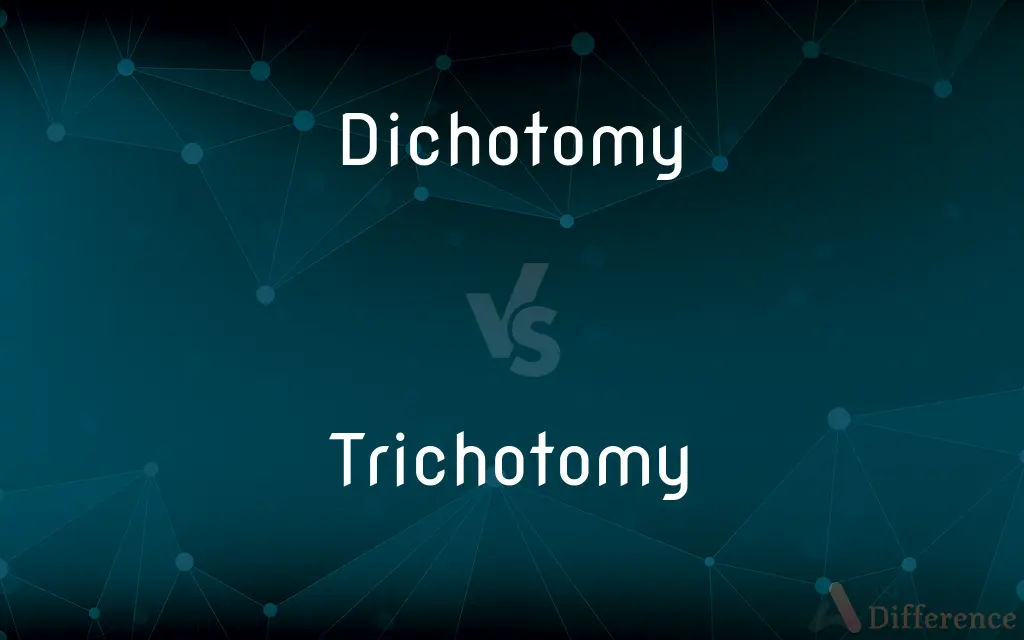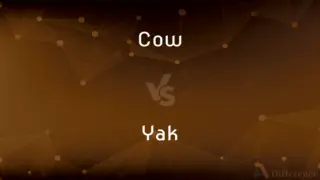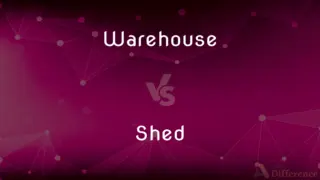Dichotomy vs. Trichotomy — What's the Difference?
Edited by Tayyaba Rehman — By Urooj Arif — Updated on April 1, 2024
Dichotomy involves a division into two parts, often contrasting, while trichotomy splits into three distinct parts or categories.

Difference Between Dichotomy and Trichotomy
Table of Contents
ADVERTISEMENT
Key Differences
Dichotomy emphasizes a clear, often binary division within a concept or phenomenon, highlighting the presence of two mutually exclusive or contradictory groups. For example, the mind-body dichotomy in philosophy separates mental phenomena from physical ones, illustrating a distinct division based on nature. Whereas trichotomy introduces a third category or element, expanding the complexity of categorization or analysis. This can be seen in personality theories, where a trichotomic approach might divide human personality into three fundamental elements, such as cognitive, affective, and behavioral components, offering a more nuanced understanding than a simple binary division.
In the realm of decision-making, dichotomy simplifies options to either/or scenarios, facilitating straightforward choices. This approach is common in binary logic systems, where statements are judged as true or false. On the other hand, trichotomy allows for a third option or outcome, which can reflect scenarios more accurately in situations where binary choices are insufficient. For instance, in voting systems, beyond "yes" and "no," there might be an option for "abstain," recognizing the legitimacy of neutrality or indecision.
When analyzing conflicts, a dichotomous framework might categorize perspectives as for or against, simplifying complex issues into two opposing sides. This is often seen in political debates or ethical dilemmas, where positions are polarized. Conversely, trichotomy can facilitate a more comprehensive exploration of conflicts by acknowledging a middle ground or alternative viewpoint, thus encouraging a broader dialogue and understanding.
In scientific classification, dichotomy is used for binary decisions at each branch point, such as in taxonomic keys for identifying species. This method efficiently narrows down options to reach a specific classification. Meanwhile, trichotomy, though less common in this context, could be used to classify organisms or phenomena into three broad groups initially, before further subdivision, offering a different approach to categorization.
In terms of data analysis, dichotomy often relates to binary variables that denote the presence or absence of a characteristic. This simplifies analysis but can also limit understanding to a yes-no framework. Trichotomy introduces a third variable or category, which can provide more detailed insights. For example, in measuring economic status, instead of just "employed" or "unemployed," a trichotomic approach might add "underemployed," capturing a more accurate picture of labor dynamics.
ADVERTISEMENT
Comparison Chart
Definition
Division into two mutually exclusive or contradictory groups.
Division into three distinct categories.
Application in Analysis
Simplifies concepts into binary options, facilitating clear distinctions.
Allows for more nuanced understanding with an additional category.
Use in Decision-making
Emphasizes either/or choices, making decisions straightforward.
Introduces a third option, accommodating complexity and nuance.
Conflict Resolution
Tends to polarize perspectives into two opposing views.
Offers a middle ground or alternative, encouraging broader dialogue.
Data Analysis
Categorizes data into binary variables, simplifying analysis.
Adds a third category for more detailed insights and understanding.
Compare with Definitions
Dichotomy
Mutually exclusive categories.
The dichotomy of public and private sectors delineates economic activities.
Trichotomy
A three-way classification system.
The trichotomy of legislative, executive, and judicial branches ensures a balance of power.
Dichotomy
A division or contrast between two things.
The dichotomy between science and religion has sparked much debate.
Trichotomy
Expanded analytical framework.
Trichotomy in ethical debates allows for nuanced discussions beyond right and wrong.
Dichotomy
Philosophical concept of dualism.
Plato's dichotomy of the ideal and the real explores the nature of existence.
Trichotomy
Incorporating a third option or category.
The personality trichotomy considers thought, emotion, and behavior.
Dichotomy
Binary classification.
The legal dichotomy of guilty or not guilty simplifies the judicial process.
Trichotomy
Triple aspect concept.
The trichotomy in data analysis can reveal patterns not visible in binary classifications.
Dichotomy
Division into two parts.
The dichotomy of good and evil is a common theme in literature.
Trichotomy
Division into three parts or elements.
Dichotomy
A dichotomy is a partition of a whole (or a set) into two parts (subsets). In other words, this couple of parts must be jointly exhaustive: everything must belong to one part or the other, and mutually exclusive: nothing can belong simultaneously to both parts.Such a partition is also frequently called a bipartition.
Trichotomy
A system based on three parts or elements, especially the theological description of humans as consisting of body, soul, and spirit.
Dichotomy
A division or contrast between two things that are or are represented as being opposed or entirely different
A rigid dichotomy between science and mysticism
Trichotomy
Division or separation into three groups or pieces.
Dichotomy
Repeated branching into two equal parts.
Trichotomy
(algebra) the property of an order relation whereby, given an ordered pair of elements (of a given algebraic structure), exactly one of these is true: the first element is 'less than' the second one, the second is 'less than' the first, or the two elements are equal.
Dichotomy
A division into two contrasting parts or categories
The dichotomy between rural and urban communities.
Regards the division between nature and nurture as a false dichotomy.
Trichotomy
Division into three parts.
Dichotomy
(Astronomy) The phase of the moon, Mercury, or Venus when half of the disk is illuminated.
Dichotomy
(Botany) Branching characterized by successive forking into two approximately equal divisions.
Dichotomy
A separation or division into two; a distinction that results in such a division.
Dichotomy
Such a division involving apparently incompatible or opposite principles; a duality.
Dichotomy
(logic) The division of a class into two disjoint subclasses that are together comprehensive, as the division of man into white and not white.
Dichotomy
The division of a genus into two species; a division into two subordinate parts.
Dichotomy
(astronomy) A phase of the moon when it appears half lit and half dark, as at the quadratures.
Dichotomy
(botany) Division and subdivision; bifurcation, as of a stem of a plant or a vein of the body into two parts as it proceeds from its origin; often successive.
Dichotomy
A cutting in two; a division.
A general breach or dichotomy with their church.
Dichotomy
Division or distribution of genera into two species; division into two subordinate parts.
Dichotomy
That phase of the moon in which it appears bisected, or shows only half its disk, as at the quadratures.
Dichotomy
Successive division and subdivision, as of a stem of a plant or a vein of the body, into two parts as it proceeds from its origin; successive bifurcation.
Dichotomy
The place where a stem or vein is forked.
Dichotomy
Division into two; especially, the division of a class into two subclasses opposed to each other by contradiction, as the division of the term man into white and not white.
Dichotomy
Being twofold; a classification into two opposed parts or subclasses;
The dichotomy between eastern and western culture
Common Curiosities
Can trichotomy be used in decision-making processes?
Yes, trichotomy can be used in decision-making to provide a third option or perspective, accommodating more complex scenarios.
How does dichotomy differ from trichotomy in analysis?
Dichotomy simplifies analysis into binary options, while trichotomy introduces a third category for a more nuanced understanding.
What is a dichotomy?
A dichotomy is a division into two mutually exclusive or contradictory groups or entities.
Is dichotomy always about opposing concepts?
While dichotomies often involve opposition, they fundamentally entail any two mutually exclusive categories.
How does trichotomy enhance conflict resolution?
By acknowledging a middle ground or alternative viewpoint, trichotomy can facilitate more comprehensive dialogue and understanding.
What is an example of trichotomy in psychology?
Freud's division of the human psyche into the id, ego, and superego is a notable example of trichotomy.
What is a trichotomy?
A trichotomy is a division into three distinct categories or groups.
Can dichotomies be found in cultural narratives?
Yes, many cultural narratives rely on dichotomies, such as the hero and villain, to structure stories.
Can you give an example of dichotomy in everyday life?
The dichotomy of night and day is an everyday example of a binary division based on natural phenomena.
How does dichotomy influence philosophical debates?
Dichotomy can polarize debates by presenting two opposing viewpoints, often simplifying complex issues.
Why is dichotomy important in scientific classification?
Dichotomy simplifies the process of identifying species by systematically narrowing down options through binary decisions.
How does trichotomy affect data analysis?
Trichotomy allows for the inclusion of a third variable, providing deeper insights than binary classifications.
How do dichotomy and trichotomy apply to ethical considerations?
They provide frameworks for understanding ethical issues, with dichotomy presenting clear-cut choices and trichotomy offering nuanced discussions.
What is the significance of trichotomy in government structures?
The trichotomy of legislative, executive, and judicial branches is crucial for balancing power and preventing tyranny.
Is a trichotomy more realistic than a dichotomy?
Trichotomy can offer a more realistic and nuanced perspective by acknowledging complexity beyond binary distinctions.
Share Your Discovery

Previous Comparison
Cow vs. Yak
Next Comparison
Warehouse vs. ShedAuthor Spotlight
Written by
Urooj ArifUrooj is a skilled content writer at Ask Difference, known for her exceptional ability to simplify complex topics into engaging and informative content. With a passion for research and a flair for clear, concise writing, she consistently delivers articles that resonate with our diverse audience.
Edited by
Tayyaba RehmanTayyaba Rehman is a distinguished writer, currently serving as a primary contributor to askdifference.com. As a researcher in semantics and etymology, Tayyaba's passion for the complexity of languages and their distinctions has found a perfect home on the platform. Tayyaba delves into the intricacies of language, distinguishing between commonly confused words and phrases, thereby providing clarity for readers worldwide.
















































